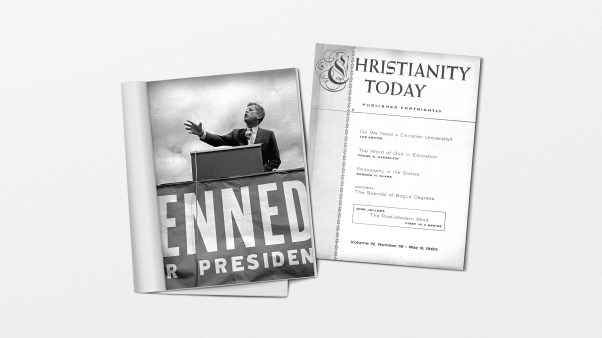Stephen Smith doesn't look like a mad scientist, because he's not one. Not really. He's not even a code guy by training. But he has packed the room at BibleTech, an occasional gathering of coders, hackers, publishers, scholars, and Bible technology enthusiasts. And the standing-room-only crowd is starting to turn on him. No pitchforks and torches. But for once in this collegial, tight-knit retreat, you can feel the tension growing.
They've seen his experiments before. You might have, too. He's the guy who wrote the code to quantify what folks on Twitter gave up for Lent and how the fasts change from year to year (forswearing swearing is up, dropping alcohol is down). He figured out what Bible verses went viral after Osama bin Laden was killed, or at any other time (chances are good that "I can do all things through him who strengthens me" and "For I know the plans I have for you" are doing really well right now), and the most popular saints and mountains in American church names. (Mt. Pisgah beats out Mt. Nebo. And Lutherans almost never call their church "First Lutheran"—though "First" is a fifth of Presbyterian churches.)
If someone releases a new API (code that lets applications interact with each other), or if Google unveils a new tool in beta, or if a new dataset is published online, it's a fairly safe bet that Smith will try to connect it to the Bible. In 2012, Stanford University published a Geospatial Network Model of the Roman World. Smith used it to calculate the time and cost of each of Paul's missionary journeys. The photo-sharing site Flickr lets users search by GPS coordinates, and he created a tool to feature contemporary photos of Bible places. Smith also used Flickr's API to look up each word in each Bible verse, grab the top 30 photos for each word, layer them on top of each other, and then take all the images from all the words in each verse and layer them on top of each other. That experiment didn't turn out well. Almost every verse just becomes a big orange blob. But it was an interesting idea.
Smith's new idea isn't so innocuous. It's scary. And Smith knows it. But he loves it anyway.
The Franken-Bible
"There are about 30 modern, high-quality translations of the Bible in English," Smith announces to the BibleTech group. "Can we combine these translations algorithmically into something that charts the possibility space of the original text?"
In other words, Smith is going to show the room what he calls his Franken-Bible maker. It's YouVersion, if that name actually meant what it suggests. With minimal effort—and no knowledge of Greek or Hebrew—you can create your own English Bible translation. You, dear reader, may not be interested in having your own personal translation that's different from the three on your shelf. But might you like one from your favorite celebrity pastor? Wouldn't a Max Lucado Version sell well? The Southern Baptist Convention has its own translation. Can a Mars Hill Church Standard be all that far behind?
Algorithms are already used heavily for translating Scripture into new languages (see CT's February 2005 article, "Wycliffe in Overdrive"). And people are already remixing existing translations—last year, for example, Dallas Theological Seminary's John Dyer created a Google Chrome extension that would indicate the plural sense of "you" in online Bibles, no matter the translation. You can choose between "y'all," "you guys," "you lot," and other regional options.
An essentially infinite glut of algorithm-created Franken-Bible translations is inevitable, Smith tells me later. "Someone is going to do this, and that will radically change how we interact with the Bible. There's no reason that I can think of why you wouldn't. I mean, obviously there are reasons—like the authority of Scripture. But from a technical perspective, it's very possible."
In fact, Smith has already done it, or at least a rough proof-of-concept version that anyone can start using at AdaptiveBible.com. As he demonstrates it, choosing among the many translation possibilities for each phrase in 1 Corinthians 13:2— "understand all mysteries" vs. "know all mysteries," and "have not love" vs. "do not love"—he assures the crowd, "I'm not saying that I think this development is a particularly great one for the church, and it's definitely not good for existing Bible translations." But you can tell that he thinks the idea is, from a technical standpoint, pretty cool.
"I definitely have mixed feelings about it," he tells me later. It takes the Protestant claim that we don't need priests to interpret the Bible for us and says we don't need academics and other experts to translate it for us, either. It thereby significantly undermines the authority of scholars and their convening institutions (translation committees and publishers). But it gives more power to informal networks, celebrity pastors, and those with a reason and means to push their own personal translation.
"It raises so many problems and doesn't really provide great answers," Smith continues. "I see Franken-Bibles as a transition. There's always this temporary chaotic phase when you have some disruption in an area. After that, things stabilize around something that is hopefully better than it was before. Whatever this will gel into will probably be better than introducing a new translation of the Bible every single year."
Still, it's a hard thing for Smith to say. "It'll be hard for the Bible industry, and this is a difficult position for me."
Smith, you see, works at Zondervan, publisher of the best-selling Bible translation of all time, the New International Version. Zondervan lured him away from Crossway, where he had been renowned as the web guy behind the launch of the English Standard Version. Now he works on Zondervan's Bible Gateway, which calls itself the most-used Christian website.
The room is filled with guys (almost entirely guys) like Smith—young men passionate about their Bibles and about writing great code, who say "disruption" with a wink because they know they say it way too often. They love Smith, but they're not buying this one. "Franken-Bibles might be easy to build, but they'll never disrupt traditional Bible translations. They'll be novelties," tweeted Keith Williams, senior editor of Bibles at Tyndale House Publishers. "People of influence won't trust them (even their own)."
Williams may be right. But consider that his employer got its start when editor Ken Taylor created an early Franken-Bible of sorts, paraphrasing the 1901 American Standard Version into words he thought people would better understand. He didn't use an algorithm, and he vetted his work with Hebrew and Greek scholars. But Billy Graham's celebrity endorsement of Taylor's Living Letters (and later the Living Bible) led people to trust it, disrupting Bible publishing unlike anything seen since.
And that's the point not just of Smith's whimsical Franken-Bible presentation, but also of almost every project everyone in this room is working on. We are all Ken Taylor now. Networked code has made us all small-scale publishers, travel agents, critics, and a hundred other job titles once left to trained professionals. Now technology is promising—or threatening—to turn all of us into Bible translators and expositors, too.
'Like Music I Never Knew Existed'
As the BibleTech guys discuss Bible translation algorithms and the prospect of a thousand new versions, other coders are working to make that quest less relevant. After all, would Bible readers need even more English translations if they could seamlessly understand the Hebrew and Greek, with access to all the information that trained Bible translators have?
In seminaries and on Bible blogs, everyone has their favorite Bible software, and the arguments over Accordance vs. BibleWorks vs. Logos can be just as feisty as any Mac vs. PC, Android vs. iPhone debate. (Generally speaking, Accordance and BibleWorks built their reputation as original language exegesis tools, while Logos traditionally emphasized integrated commentaries and other resources. Accordance has a heavy following among Apple fans; BibleWorks has a reputation for trying to keep user costs down.)
But few people grasp just how big Logos has become. It has more than 380 employees in Bellingham, a Washington port city 90 miles north of Seattle. Its website currently lists another 75 job openings. It has another office in Tempe, Arizona (there are daily meetings over Skype, with flat-screen TVs displaying live webcams of each others' offices all day). There's a state university on the other end of town, but more than 1 in 23 people working in downtown Bellingham work for Logos. With workers in three major downtown buildings, including the city's seven-story triangular Flatiron Building, it has a large footprint.
And it's still not enough. Last summer, Logos CEO Bob Pritchett proposed building an 18-story building, the city's tallest, to bring his employees under one roof (they currently have to rent a nearby theater for all-staff meetings). Local response was mixed, which may suit Pritchett just fine. "We may have to leave Bellingham," he told me. "We're struggling to hire people who are willing to move here."
Which is kind of remarkable. Logos, after all, doesn't just make the list of "Best Christian Workplaces" every year—it also ranked #10 in Glassdoor's "Best Medium-Sized Companies to Work For" out of, you know, all medium-sized companies to work for. The office isn't Google-ridiculous, but it looks a lot more like Microsoft and other Washington tech companies than it does most Christian businesses. There's the unlimited free supply of high-quality caffeinated drinks, of course. In the Outdoor Center you can get your bike professionally tuned or borrow a kayak or tent. In the Commons, there's shelves full of DVDs, and every console game you can imagine to take home—or to play on the Commons' massive flat-screen TVs, next to the foosball and ping-pong tables. Down in the music center, employees can play on high-end guitars, keyboards, and drums. It's probably worth noting that no one is playing with any of these things during my stroll through the office. Few are socializing. Everyone is hunkered down at their desks.
Except for CEO Bob Pritchett, who seems to be in perpetual motion. If you Google him, you'll get the expected links to the company, his blog, and his provocative business book, Fire Someone Today. (Once a year, Pritchett has a "read for cash" program: employees read business books at 15 cents a page and email a review to the rest of the staff.)
You'll also find a link to his slide presentation on "How to Quit College and Get Away With It!" He's serious. If technology is poised to radically democratize Bible publishing, it's already toppling the ivory towers. "Colleges are guilds for academics," says one slide. If you want to join the guild, or if you're not good at learning on your own, then go ahead and finish college. But for most of us, he says, it's a bad investment, now that education is essentially free. "Quitting college is not about quitting education," he wrote. "It's about taking responsibility for your own education."
"You carry a device in your pocket that gives you instant access to the sum of human knowledge and lets you communicate directly with almost every intellectually or economically engaged person on earth," he said. "This is unprecedented in the course of human history. This is not a modern twist on an ancient idea."
This is not what you'd expect to hear from someone whose clientele is mostly seminary and graduate students. (Logos just struck a deal with Dallas Theological Seminary to give all students the $1,000 version of its program and about $800 worth of other Logos resources; if you graduate, you get to keep them.)
"I don't want to denigrate wise and godly leaders," Pritchett says when asked how his views on college relate to the goals of his software. "We still need experts." But, he says, we don't need them in order to access information and knowledge. "My mom used to use Vine's [Expository Dictionary, a classic English–Greek reference tool] in her studies because she didn't know Greek. Now she uses lexicons that a few years ago you literally couldn't use without knowing the Greek. We are removing the friction from studying the Bible."
Some of his presentation is simply tech-company entrepreneur boilerplate—after all, this is an industry dominated by college dropouts, from Bill Gates to Mark Zuckerberg. But Logos interaction designer Eli Evans says the company and, indeed, the whole Bible tech sector believes that the Information Revolution is doing to the "academic priesthood" what the Protestant Reformation did to Catholic priests—and laypeople.
"The academy does a good job of teaching you the tribal language and creating new initiates," Evans says. "It's not really about giving you information. It's about having great conversations." But working with Bible technology all day has had much the same effect, he says. "It has shifted my imagination of what's possible. It's like being introduced to different kinds of music I never knew existed. It demystified the text for me, making it more mundane and more beautiful at the same time."
Bible tech has provided personal epiphanies, such as when he learned the Hebrew word for bread, lehem. "Lehem is bread! Bethlehem means 'House of Bread'! Jesus is the Bread of Life! Hebrew is magic!" But the same software that draws such connections also taught him to think more skeptically—even about the very connections that got him so excited, Evans said. "What we're doing here makes it very easy to run with theological scissors."
The tools can be used, to use an example several people referenced, to develop an intense numerological theory about the significance of the 153 fish caught in John 21. It's kind of a throwback to the early church, when preachers loved pontificating on repeated words, images, and numbers in disparate biblical books. But database-driven interactive text seems to especially encourage this kind of reading, where one simple mouse click pulls up thousands of pages of cross-references and commentary on each word. It's an awful lot like 2001's A Beautiful Mind, where Nobel laureate John Nash is able to see real patterns no one else had seen—but also sees patterns that don't really exist.
However, Evans says, "the access to information will dampen that effect. It makes possible easy information and easy verification."
Access to information was the old problem. Logos has been blowing up books for years now. They know how to take a new volume and turn it into data. Now the big issue is sifting through that information and curating it.
'You can slice and dice a huge amount of information now that it doesn't require memorizing lots of facts,' says Logos's Eli Evans. You don't have to be an expert. You just have to know how to search.
Hence the selling points for the latest version of Logos. Search for the word "Jesus" as a basic Bible word search on, say, BibleGateway.com or a paper concordance, and you get about 800 references. Search for it on Logos, where all of the pronouns referring to Jesus are tagged (all 2,917 of them), along with every time Jesus is the implied subject of a verb (2,280 times), and all the times he's referred to as "Teacher" (33 times) or "Son" (96) or "Lord" (622) or anything else: That's more than 10,000 references to Jesus. That can get unwieldy. Then again, Logos's search function makes it awfully easy to find all the times Jesus heals, all the objects of Jesus' love, and all the things he said about money. Most searches for passages that put Jesus in Jerusalem won't return "Then the devil took him to the holy city" (Matt. 4:5), but it will in Logos. True, most of those examples have long been compiled in books. The difference is that now they're compiled in databases. (So you can see, for example, whether Jesus talked more about money when he was in Jerusalem than when he was traveling the Judean countryside.)
"You can 'master'—by which I mean slice and dice—a huge amount of information now that it doesn't require memorizing lots of facts," says Evans. You don't have to be an expert, he says. You just have to know how to search.
Such was the genesis of Logos. "I got into using computers in the third grade," Pritchett says. "I had The WORD Processor for the Apple IIe [the first Bible software for Apple computers], and I had to use 50 disks to search the whole Bible. It was interesting tech, but it wasn't that useful."
In 1986, around the time he found an online bulletin board where someone had posted the King James Version, he learned about a new algorithm that would search text files faster. He put the two together and built a mailing list of people he thought would be interested in a "faster Strong's [concordance]," and distributed it as a hobby while working for Microsoft.
"I still don't fit the typical Logos user profile," he says. "I'm not the Bible scholar I wish I was. When I go deeper into the Bible, it's still pretty shallow [compared to] most of our users." The son of a librarian, Pritchett says the thing he loves most about his software is that he can mark it up endlessly. "[In my childhood,] we couldn't take notes in our Bibles. We couldn't highlight anything. I take a lot more notes and highlights now."
Most of the time, he says, he uses the program to follow a daily reading plan and to read an occasional sermon. He does carry it to church on his iPad. In Washington, he says, there's no stigma about turning on a screen in the sanctuary, and no one wonders if you're checking your e-mail. He doesn't check e-mail, but he does find himself going from "following along" with the sermon to "skipping ahead" and reading Logos's study notes.
"I usually can't watch TV without looking stuff up on Wikipedia, either," he says. "I like to follow rabbit trails. But I want curated rabbit trails. I want to be taken to places I'd never go to."
What to do with an Ox
It's no surprise that Pritchett finds himself following rabbit trails when he opens his digital Bible. Digital text is rabbit trails all the way down. The promise of a radically hypertext Bible is that it allows us to see and explore the unity of Scripture—its connections and themes and stories. "I think a lot more about intertestamental connections," one Logos worker told me. "When I see the Old Testament quoted in the New Testament, I can go into the original languages and look at word meanings, and see harmony where I used to see discord."
That connectivity is one of the reasons the Bible geeks are so enthralled by visualizations and infographics, which are pasted all over Logos cubicle walls and fill Stephen Smith's OpenBible.info blog. One of Smith's first Bible hacking projects was to crowdsource 340,000 cross-references and then chart them. Elsewhere, ESV has a nifty chart of cross-references, as do other authors. The atheists have even made a couple, charting the supposed contradictions between verses. It's silly, but then a lot of those 340,000 "cross-references" have only the slightest of connections, too.
One unpublished infographic that was popular inside Logos was by Vincent Setterholm, an information architect in the company's content innovation team. It's a massive flow chart describing what to do with an ox. (Was your oxen harmed? Did your ox fall into a pit? Do you own the pit?)
"It was inspired by a handheld electronic 20 questions game that was uncannily efficient at identifying just about any object I could imagine," Setterholm said. "It made me wonder if the 613 mitzvot could be represented in a flow chart of yes/no answers. My working title for the project, of which only 'Oxen Law' and 'Mold Law' are drafted, was the Toracle. It was a proof-of-concept, and perhaps more amusing than edifying."
He's probably right that some would find it snarky or irrelevant Bible trivia. (We liked it enough to publish it with Setterholm's permission.) But the point was never to tell people what to do with an ox. It was to try out one way to put some of the Bible back together after taking it apart and turning it into data. Could it be that a flow chart can help you see things that straight text can't? If you put the Bible in a flow chart, is it still the Bible? That's the question posed at BibleTech by Keith Williams and fellow Tyndale Bible editor Adam Graber (a media ecologist by training; it's hard to find a Bible programmer who actually has a degree in a computer science field). Most evangelicals wouldn't consider the History Channel miniseries The Bible to actually be "the Bible," but do their neighbors? What makes it not "the Bible"? If you answered, "Because it leaves most of the Bible out and puts a lot of extrabiblical stuff in," consider that most evangelicals, when they say they read "the Bible," often read only a few verses with a commentary, study notes, or an attached devotional.
Can a flow chart of Bible data help you see things that straight text can't? If you put the Bible in a flow chart, is it still the Bible?
"Most of us read the Bible in a very atomized way," Williams says. "It's part of our Western culture and our Christian culture. And in one sense, that's exactly what grad school does. In each course, you're laser focused. My thesis was just on Paul and the law in Galatians 3:27–28."
Study Bibles design, Bible tech, and advanced education essentially encourage the idea that reading "vertically" is better than reading "horizontally," he says. It suggests that you'll be wiser if you stop and drill down into commentaries and original languages than if you just read on to the next sentence. "Atomization isn't always bad," Williams says. "But it is when people engage Scripture only that way. The problem isn't created by digital culture, but it is exacerbated by digital culture."
When we open our print Bibles, he points out, the most eye-catching things on the page are almost never what we would consider the text of Scripture. If it's a study Bible, notes are usually given design priority. If not, our chapter numbers (introduced in the 1200s) or section titles draw the eye.
Online Bibles almost always make things worse, Williams says. Search for a verse, and search results often return only that verse—not that verse in context. But if digital media can really disrupt print media, he asks, why not disrupt verse numbers, added after the high-speed press so that multiple people in a room could refer to the same passage? "Now you can all go to Galatians 3:27, but none of you have to actually see that it's verse 27," he says. "You could treat the verse numbers as invisible metadata, and start referring to things as a community." So long as individual verses are the primary way we engage with Scripture, he says, "Philippians 4:13 is going to refer to an athletic performance rather than perseverance through need."
And if tagging verses in print led to unforeseen rampant prooftexting, what might be the side effects of digital Bible atomization, where every word is turned into its own piece of data and tagged (in Logos's case) at least seven different ways?
Hacking the Bible
But that's too clean a comparison, says Williams. Tyndale's print Bibles are deeply tagged and based on a massive number of scripts and schemas. In the code for the Chronological Study Bible, for example, "The text is almost as atomized as it can be. The difference is that the final product reflects my decisions on how it should be instead of the user's." The code lets Tyndale create new Bibles in months instead of years, and lets them publish them simultaneously for bookstores, iPads, Kindles, and several other formats.
"I totally felt like I was hacking the Bible," Williams said. "Almost everything I was doing wouldn't have been possible in a pre-digital time." And people still love their print Bibles: The New Living Translation came out in 1996, but Tyndale sold more print copies of it in 2012 (the last year it had figures for at press time) than ever before.
Zondervan, meanwhile, has tried to address some of the problems Williams noted about extrabiblical additions being given heavier weight than Bible text. In a recent Bible they published, the design did not highlight notes or chapter numbers, but rather the most popular verses, based on what verses people looked up on BibleGateway.com.
"It did not do well in the market," says Smith. It may have only exacerbated the versification problem. With different type sizes, weights, and colors, it was painful to read an entire chapter. Or it may be that, while evangelical Protestants have always wanted more and more people reading the Bible, they can get nervous about "popular" use of it. The Bible geeks may be right that the technology is radically democratizing Bible scholarship, undercutting traditional gatekeeping. But it may be a long time before we trust "collective intelligence" on the Bible, let alone our own.
As more of us switch from paper Bibles to data-driven electronic ones, our personal Bible reading may start to look like the Bible hackers'. Not all of them swipe tablets in the sanctuary; some avoid screens at church altogether. Some are drawn to liturgical churches; others find themselves leaving them. Most of them said that working on the Bible all day made them less likely to spend time with it after hours. They found it harder to read Scripture without technical questions distracting them. But almost all of them said their work made them more curious about different interpretations of the text, especially the text as a whole.
"I find myself more gracious," said one Logos employee. "I'm a lot less likely to call someone a heretic since I can generally retrace their steps and see how they got there."
Still, subtle heresies really can creep in, Smith says. It's true of a digital library of thousands of commentaries. It's true of Franken-Bible translations, too. "How do you trust that what you're reading isn't just wrong enough to lead you down a totally wrong path? You can get the questions. That's easy. The hard part is getting the answers."
But even that might be simpler than getting people to keep reading the Bible text, with all those questions and answers just a click away.
Ted Olsen is CT's managing editor for news and online journalism.










